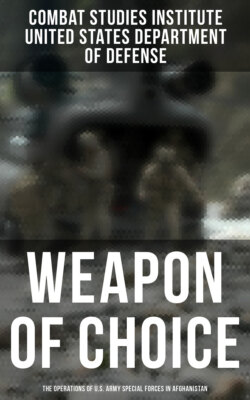Читать книгу Weapon of Choice: The Operations of U.S. Army Special Forces in Afghanistan - Combat Studies Institute - Страница 19
На сайте Литреса книга снята с продажи.
Site Coordination With the Uzbeks at Karshi Kanabad
ОглавлениеBefore the first meal had been cooked, the first tent erected, or the first aircraft launched, an advance echelon (ADVON) had preceded the main body of troops. This ADVON of specifically chosen personnel normally arrives early to establish rapport with foreign government officials and local inhabitants. This small element makes necessary arrangements to efficiently receive the main body of soldiers and equipment, usually arriving by aircraft for a military operation. The initial ADVON to K2 Air Base, a former Soviet installation in Uzbekistan, consisted of a three-man team from Fort Campbell and an 11-person SOCCENT element from Tampa. It was to evaluate what eventually became Stronghold Freedom, most commonly referred to as “K2.” Its mission was to assess the logistics and operational facilities of the base and to coordinate with local officials to build an infrastructure that would support approximately 3,500 people.
According to Staff Sergeant (SSG) James Willet (pseudonym), the 2nd Battalion, 160th SOAR logistics NCO, an “old hand” with ADVON duty, the Uzbek air base commander at K2 was not really happy to have Americans on his base. He was worried about their personal safety and about possible retribution from the Islamic Movement of Uzbekistan (IMU), a militant terrorist group based across the border in Afghanistan. Willet said, “It was weird and kind of eerie being one of only ten Americans, and constantly watched by Uzbek soldiers. When I left high school it [Uzbekistan] was still Russia, and I had never heard of Uzbekistan.”
Figure 32. Karshi Karnabad (K2), Uzbekistan.
Once settled, SSG Willet made initial contact with the air base commander, an Uzbek Air Force lieutenant colonel, through an interpreter and quickly developed positive rapport, despite the wide disparity in ranks. Willet explained that the ADVON traveled light and that he needed to buy supplies and rent equipment. Concerned about their good relationship, the Americans did not want to exploit the Uzbek commander’s generosity. It took some convincing before he was granted permission and escorted by an Uzbek pilot. Willet and his interpreter were driven to the open-air market in the village. Dressed in khaki trousers and a sports shirt, and carrying an M-9 automatic, the 6-foot, blonde-haired, blue-eyed American was “head and shoulders” above everyone in the Asian crowd as he moved among the vendors’ stalls. Feeling very conspicuous and surrounded, Willet was glad that the Uzbek colonel had insisted on the escort. After making his purchases in soms, the local currency, the trio returned without incident. Until the evening, that is, when Willet realized his visit to the market had made him a television celebrity on the local news. The Americans had truly arrived.
Figure 33. K2, Uzbekistan.
Over the course of the next few days, Lieutenant Commander (Lt Cdr) Millender (pseudonym) from SOCCENT met with the military commander and other local Uzbek officials, negotiating as much space as possible for the incoming American forces. However, it was the Uzbek commander of the Joint Chiefs of Staff, General Kasymov, who ultimately decided the boundaries. Kasymov marched to the western edge of an unused taxiway, stopped, and decreed, “From this point that way is yours; nothing more!” This, as the Americans quickly discovered, was how everything was accomplished in Uzbekistan. Operating in a slow, bureaucratic manner, all officials had to call their superiors for final approval. It was only after Uzbekistan President Islam Karimov had personally given Defense Secretary Rumsfeld permission to use the air base for search-and-rescue missions that the main body of U.S. forces was allowed to arrive. Colonels became primary action officers for getting things done in this former Soviet republic.
While diplomatic negotiations continued, the rest of the ADVON began setting up the tactical operations center (TOC) in the only building allotted, an old Soviet-era structure with paint peeling off the walls and broken windows. While the building had only a few separate rooms and was poorly ventilated, it became the central resourcing point for the ADVON party. U.S. Air Force CPT Paul West (pseudonym) conducted a survey of the taxiways and runway to accommodate the arrival, unloading, refueling, and departure of C-17 jet transport aircraft. He also reviewed U.S. military air traffic control procedures with the Uzbek air traffic control officials to ensure that they fully understood the differences. MAJ Kyle Killinger (pseudonym), a contracting offi- cer from SOCCENT, arranged for fuel deliveries (aircraft and heating), building materials, supplies, and laborers with local businesses and government officials. The future economic benefit was not lost on any of the Uzbek hierarchy or the local population; these visitors would help the local economy. SSG Willet’s rapport with the air base commander enabled him to wrangle seven aircraft bunkers for incoming helicopters and airplanes to better divide the available real estate. A force protection assessment evaluated the airfield’s security and prioritized needed improvements, especially to the old earthen berm around the aircraft bunkers. The daily coordination meeting between Millender and the Uzbek colonel in charge of base logistics mandated nightly progress reports from the entire ADVON. On 2 October 2001, the worst sandstorm in 50 years hammered K2. With more storms predicted, acquiring temporary troop shelters escalated to the top priority. The Uzbeks provided 19 general purpose burlap tents.
Figure 34. Uzbeck guards—the bottom of the bureaucratic ladder.
